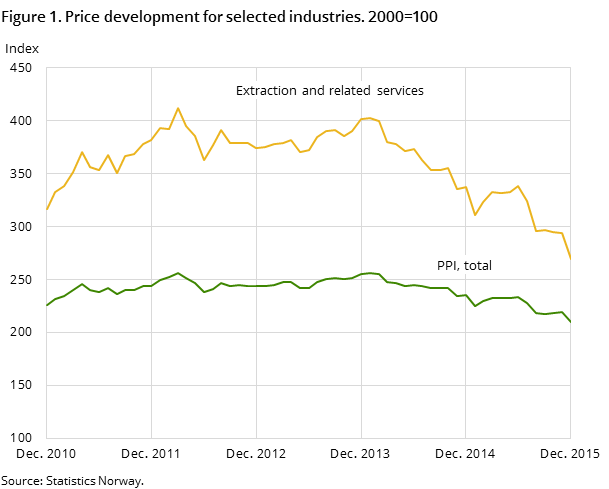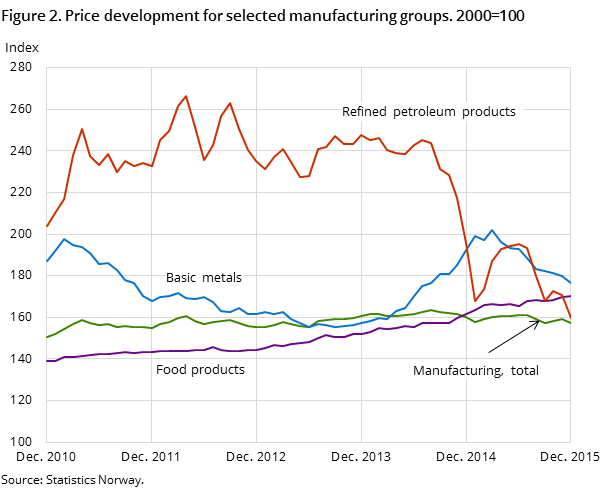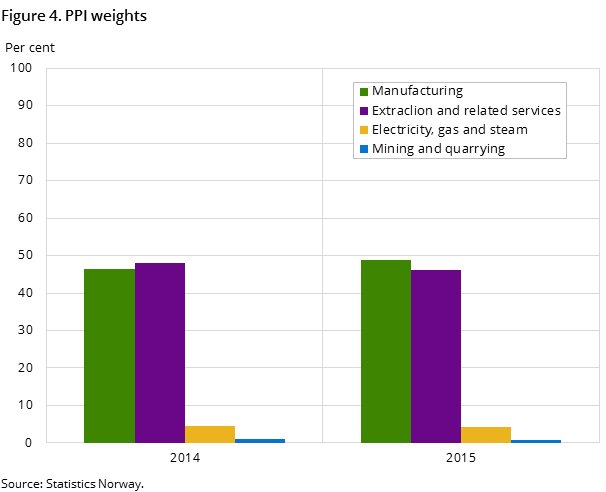Content
Published:
This is an archived release.
Price decrease on energy goods
The producer price index for oil and gas, manufacturing, mining and electricity (PPI) decreased by 4.5 per cent from November to December. The fall in the PPI was mainly due to a price drop of crude oil of approximately 15 per cent.
| Industrial Classification | Index change in per cent | Index | Weights1 | |
|---|---|---|---|---|
| November 2015 - December 2015 | December 2014 - December 2015 | |||
| 1The weights are updated annually, and are valid for the entire year. | ||||
| Extraction, mining, manufacturing and electricity | -4.5 | -10.8 | 209.8 | 1 000.0 |
| Extraction and related services | -8.2 | -20.2 | 269.3 | 460.7 |
| Mining and quarrying | 0.6 | 6.4 | 177.5 | 9.0 |
| Manufacturing | -1.1 | -1.6 | 157.4 | 488.6 |
| Food products | 0.4 | 5.4 | 170.5 | 99.6 |
| Refined petroleum products | -6.4 | -18.3 | 159.7 | 86.9 |
| Basic metals | -2.1 | -8.4 | 176.3 | 39.1 |
| Machinery and equipment | 0.0 | 1.6 | 160.3 | 52.8 |
| Electricity, gas and steam | -10.2 | -18.7 | 202.2 | 41.7 |




The total decline in the PPI from November to December can be explained by the lower oil price. The price of Brent blend, measured in NOK, fell by 15.4 per cent in December, and reached its lowest level since April 2009.
Lower electricity prices
From November to December, prices of electricity fell by about 10 per cent. This is abnormal for this time of year and is due to mild weather with heavy rainfall through most of December. In addition, extreme weather and large wind power production in Sweden contributed to lower prices in the Nordic electricity market. The price fall in December followed four consecutive months of price increases in the electricity market.
Manufacturing prices going down
The total index for manufacturing fell by 1.1 per cent from November to December. Prices of petroleum products had the strongest influence. Manufacturing prices have been falling steadily from around mid-2014.
The prices of basic metals fell by about 2 per cent from November to December. Most of the products within basic metals had price declines, but the price reduction in the industry was mostly influenced by falling prices for non-ferrous metals. Aluminium and nickel fell continually since March 2015.
Higher food prices
Prices within food products rose by 0.4 per cent from November to December, mainly due to higher fish prices. Fish prices have remained relatively high throughout most of 2015, and reached an “all time high” level in December 2015.
Annual change - price fall in the PPI
From 2014 to 2015, the PPI fell 8.1 per cent, compared with the fall of 1.4 per cent from 2013 to 2014. Decreasing prices on energy goods can explain the negative annual growth from 2014 to 2015. Prices within extraction of oil and natural gas fell by 18 per cent during this period, with the average price of crude oil, Brent blend, falling by 30 per cent.
Additional information
Contact
-
Producer price index
E-mail: produsentpris@ssb.no
tel.: (+47) 21 09 40 00
-
Elisabeth Mælum
E-mail: elisabeth.maelum@ssb.no
tel.: (+47) 97 01 28 49
-
Morten Madshus
E-mail: morten.madshus@ssb.no
tel.: (+47) 40 90 26 94
-
Monika Græsli Engebretsen
E-mail: monika.graesli.engebretsen@ssb.no
tel.: (+47) 40 90 23 71
-
Håvard Georg Jensen
E-mail: havard.jensen@ssb.no
tel.: (+47) 40 90 26 86
